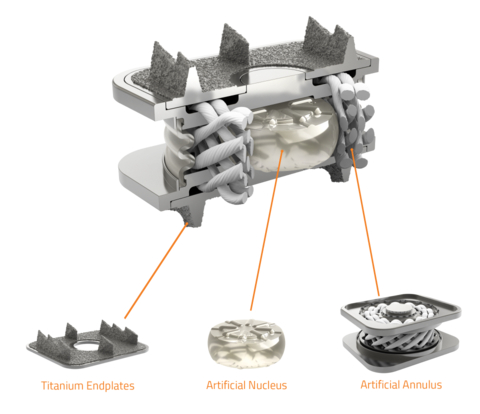
LEWISVILLE, Texas– Orthofix Medical Inc. (NASDAQ:OFIX), a global medical device company with a spine and orthopedics focus, today announced the presentation of five-year data from the M6-C™ artificial cervical disc single-level IDE study. These results will be presented on Friday, June 3 during the International Society for the Advancement of Spine Surgery (ISASS) annual meeting at The Atlantis Hotel in Nassau, Bahamas.
“We are pleased to see that at five years postoperative, participants in the study who received the M6-C artificial cervical disc continue to show significant benefits in Neck Disability Index (NDI) scores and neck and shoulder/arm pain Visual Analog Scale (VAS) scores compared to patients who received anterior cervical discectomy and fusion (ACDF),” said Dr. Frank Phillips, Professor of Orthopedic Surgery at Rush University Medical Center and an investigator in the study, who will present the data at the ISASS meeting. “Additionally, M6-C patients in the study had a low rate of revision surgery compared to the ACDF cohort. Patients in the study will be monitored out to 10 years post-op as we continue to compile the data supporting the efficacy and benefits of cervical disc arthroplasty with the M6-C disc.”
U.S. IDE study results at five years indicate:
- At five years, patients receiving the M6-C disc experienced a mean NDI improvement from the baseline of 47.5 points compared to 33.4 for the ACDF cohort, significantly better for the M6-C disc group.
- Statistically significant favorable results were observed in shoulder/arm pain VAS scores at five-years, with a mean of 0.5 for M6-C disc study patients and 2.1 for ACDF participants. There was a mean improvement from baseline of 6.8 for M6-C disc patients compared to 5.2 for the ACDF cohort.
- At the five-year endpoint, the M6-C artificial cervical disc continues to demonstrate one of the lowest Subsequent Surgical Interventions (SSI) rates at 3.1 percent when compared to other FDA-approved artificial cervical discs, suggesting that these rates are consistent with data reported for other FDA approved devices.
- Through five years post-op, five M6-C study patients experienced SSIs at the index level. Of the removals, two were performed due to persistent neck and arm pain (with one being replaced by a new M6-C disc,) and one was performed due to bone loss associated with a confirmed infection. In the ACDF cohort, 11 patients underwent SSIs during the five-year post-op period.
In addition to Dr. Phillips’s presentation of the five-year IDE trial data, Dr. Avinash Patwardhan, Director of the Musculoskeletal Biomechanics Laboratory at Edward Hines Jr. VA Hospital will present analysis of data regarding the likelihood of achieving physiological range of motion after cervical disc arthroplasty on Friday, June 3, during the annual meeting. This research aimed to calculate the proportion of reconstructed disc segments which yielded flexion-extension motion in the physiological range (defined as 5-16 degrees) by analyzing 24-month postoperative data reported from clinical trials of various cervical disc prostheses. On average, two-thirds of implanted segments in this cohort achieved two-year post-cervical disc arthroplasty in the 5–16-degree range, meeting the functional goals of mobility and stability after Cervical Disc Arthroplasty (CDA).
“Mobility and stability are two essential requirements which allow a spinal segment to function in harmony with its neighboring segments,” said Dr. Avinash Patwardhan. “The M6-C disc, with its inherent progressive resistance to motion provided by the nucleus-annulus design, yielded the highest proportion (103/131 or 79 percent) of implanted segments in the physiological motion range compared to the cohort average of 65 percent. These results support the functional goals of CDA which include restoring segmental range of motion and reducing the risk of accelerated adjacent segment degeneration.”
“We continue to be pleased with the U.S. IDE clinical data that now includes five-year outcomes,” said Orthofix President of Global Spine Kevin Kenny. “We recognize the importance of the ongoing collection of data from the U.S. study and implanting centers around the globe in order to expand the body of evidence that supports the clinical performance and safety of the M6-C artificial cervical disc. We look forward to continuing to disseminate and publish that data.”

